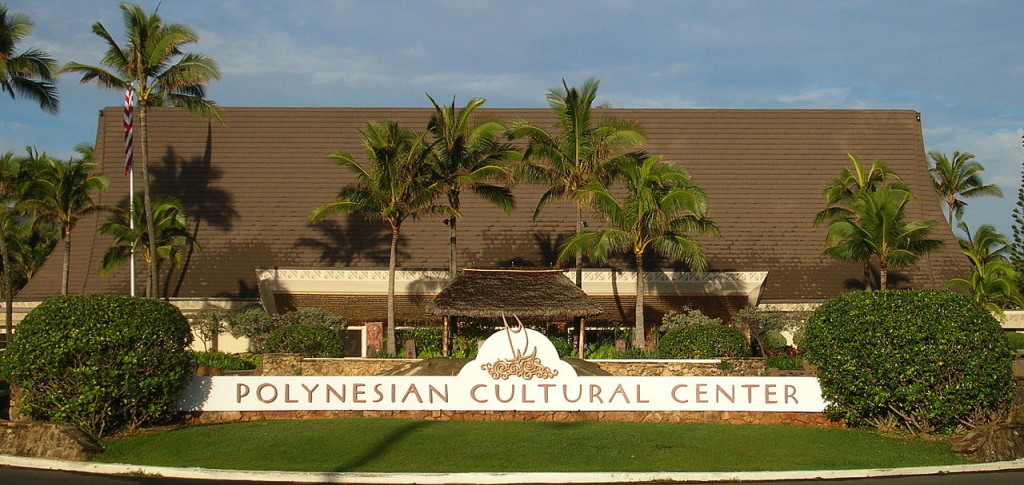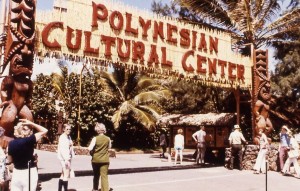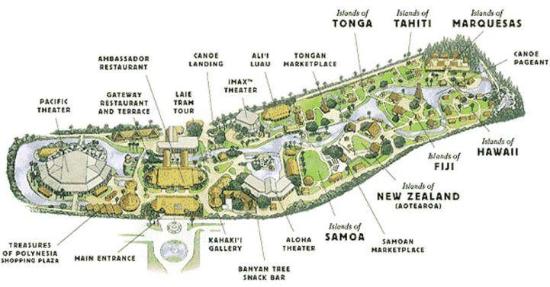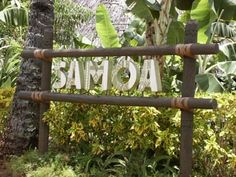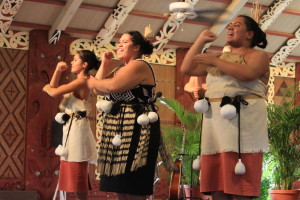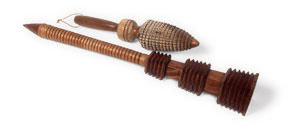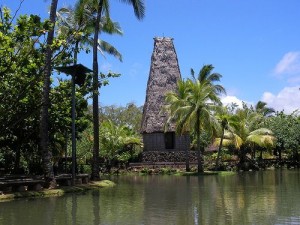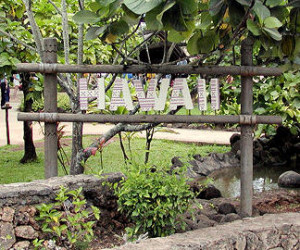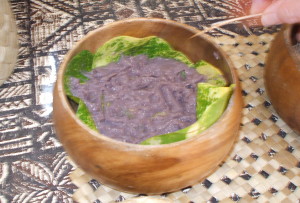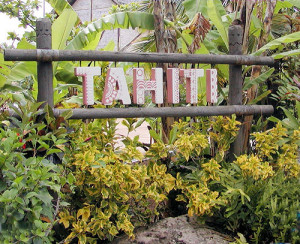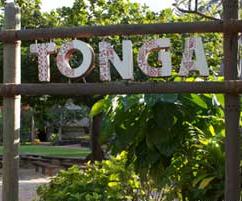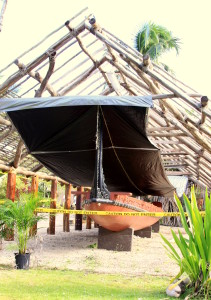A few years ago I did a Travel Post, Hawaii – the 50th State, which discussed the history of Hawaii and offered travel suggestions and points of interest to see when planning a trip. One of those places to visit was the Polynesian Cultural Center located on the island of Oahu about 32 miles from Honolulu. The Polynesian Cultural Center is a great place to experience the many cultures of the islands of the Pacific Ocean. In this post I will discuss the origin of the Center as well as important tourist information pertaining to the various activities available for visitors.
A brief history of the Polynesian Cultural Center
The Polynesian Cultural Center is located in Laie on the island of Oahu. The Center is operated by the Church of Jesus Christ of Latter Day Saints (known as the LDS or the Mormon Church) and it opened on October 12, 1963. The Center occupies 42 acres located near the Brigham Young University – Hawaii and the LDS Laie Hawaii Temple and for this reason the Center is mostly staffed by BYU students.
Back in the 1940s and the 1950s, the local LDS Church would hold traditional luaus and hukilaus (a festive beach gathering with Hawaiian song and dance entertainment) as a way to earn money to rebuild the local church that was destroyed in a fire. The gatherings proved to be very popular with the locals and the tourists, so in the 1960s the idea expanded into a permanent theme park/living history museum. The original purpose of the Center was to provide employment for the BYU students and also to preserve the cultures of Polynesia.
Polynesian Cultural Center Visitor information
When visiting the Polynesian Cultural Center there are several different admission packages. General admission includes: access to explore the different island villages, the canoe pageant, tram tour of Historical Laie, and the IMAX film “Hawaiian Journey”. Other packages include a variety of dining and entertainment experiences selections, such as Ali’i Luau dinner/show, the Island or Prime Rib buffets and the evening spectacular “HA: Breath of Life” evening show. Visitors may also take a free shuttle tour of the BYU campus, the Laie Hawaii Temple ant the LDS visitor center. For more information regarding the different types of package options and pricing, please see the Polynesian Cultural Center website – www.polynesia.com
“Hawaiian Journey” IMAX film –
A great place to start a visit at the Polynesian Cultural Center is by seeing the IMAX “Hawaiian Journey” film. The 14-minute film offers spectacular scenes of Hawaii and features special effects that allow visitors to feel the ocean spray and the rumble of a volcano. (Special Note: There are “regular” seats available if visitors do not wish to experience the special effects)
“HA – Breath of Life” evening show –
The “HA – Breath of Life” evening show is a shown once nightly in the 2,700 capacity Pacific Theatre, the amphitheater is beautifully landscaped with tropical plants and waterfalls. The show, which premiered in 2011, is an extravagant special effects production with a cast of over 100 performers and tells the story of a Polynesian man named Mana and his journey through life experiencing love, tragedy and triumph. The show features songs and dances from the different villages featured at the Polynesian Cultural Center. Of course, one of the highlights of the show is the dramatic fireknives performers. (Special Note: The amphitheater has terraced seating; according to the Center website they recommend seating in the Ambassador sections although any seat in the house will provide good viewing. Also, Hawaiian evenings can sometimes get chilly and the theater is open-air, so I would recommend having a light sweater or jacket handy just in case)
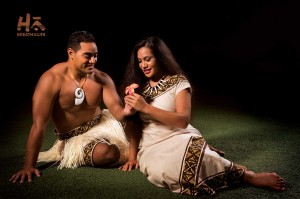
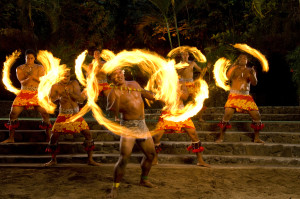
Canoe Pageant –
Meandering throughout the villages is a canal of water and lagoon where once daily there is a special performance featuring the different Polynesian regions. On each double-hulled canoe, one from each of the different villages, there are performers dressed in colorful traditional costumes which dance and play the music of their region. The current canoe pageant premiered in May 2010 and is called “Rainbows of Paradise”. (Special Note: Be sure to check for the Canoe Pageant current show time when you first arrive at the Center and arrive early to the lagoon area before the show to get a good viewing spot)
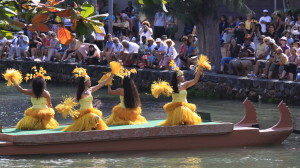
Polynesian Cultural Center Villages –
As visitors enter the Polynesian Cultural Center, to the right of the visitor/orientation center there are several different Polynesian villages set around the main canal and lagoon. Starting to the right of the main entrance and moving counter clockwise, the first village visitors will encounter is Samoa, then Aotearoa (islands of New Zealand), Fiji, Hawaii, the Marquesas Islands, Tahiti and Tonga. Each village showcases their individual culture through entertainment performances and cultural learning experiences through demonstrations, exhibitions and crafts. There is also a special exhibit on Rapa Nui (Easter Island).
Listed below are the Polynesian Cultural Center villages and a brief description of each:
Samoa Village –
Samoa is comprised of two separate areas located about halfway between Hawaii and New Zealand, the independent nation of Samoa and the smaller American Samoa, the only U.S. territory located south of the equator. Both nations speak the same language and share the same cultural traditions. Samoans are generally known for their good nature and enjoyment of life.
The Samoa village has several presentation times throughout the day and the demonstrations are interesting and very entertaining. Some of the demonstrations are how to start a fire with two sticks, how to crack open a coconut and how to climb a coconut tree.
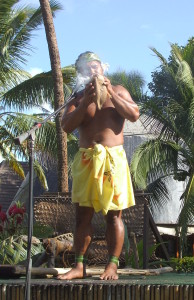
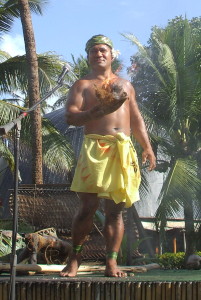
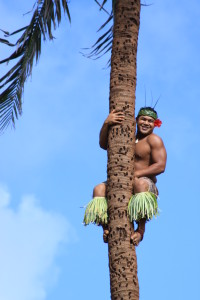
Aotearoa (New Zealand) Village –
Aotearoa is the Maori name given to the northern island of New Zealand, the most common translation is “the land of the long white cloud” which has been used by the Maori people for 1,000 years. (Special note: As visitors enter the Aotearoa village listen for the traditional Maori greeting “Kia Ora”, which means good health)
The Aotearoa village has a limited number of presentation times throughout the day. After visitors enter the Maori meeting house, the guides will give a brief explanation of the intricate carving and the symbolic significance of the various architectural features. The guides will also explain the unusual Maori facial tattoos and their ancient origins, they will also explain the meaning behind their iconic protruding tongue gesture. Performances at the Aotearoa village include the haka (the Maori war dance) and a rhythmic dance using poi balls (originally made of dried moss wrapped with raupo or flax). Demonstrations include the tititorea (a Maori stick game) which is used in training hand and eye coordination, the object of the game is not to drop the sticks as they are passed in various patterns and in rhythm to the music. (Special note: Before leaving the Aotearoa village, a fun idea for children or adults is to receive a temporary Maori tattoo)
Fiji Village –
The independent nations of the Fiji Islands are located near the equator. Historically, the people of Fiji have been known as seafarers that have traveled throughout the Pacific over several thousand years interacting with many of the other Polynesian people. In 1874 Fiji became a British colony and laborers from India were brought in to work on the sugar plantations then, after almost one hundred years, the British government granted Fiji independence in 1970.
When visiting the Fiji village, be sure to see the cultural presentations and demonstrations which are given several times during the day. Visitors will see a Lali (log drum) musical presentation and a poi ball dance. While in the Fiji village be sure to see the various types of Fiji weapons made from tropical hardwoods, such as the I wau (a type of war club) and I ula (a throwing club with a short handle and bulbous head.
Also be sure explore the Fiji village temple (Bure Kalou or “spirit house”) and other village houses, such as the Vale Levu (Fijian chief’s house) which has specific doors for servants and visitors, another for the chief’s family and one exclusively for the use of the chief. Tradition states that anyone entering the chief’s door can be put to death.
Hawaii Village –
Hawaii became the 50th state on August 21, 1959 and is an archipelago (a group of islands stretched over a body of water). The volcanically formed islands stretch over 1,500 miles in the Pacific Ocean and the eight main islands from northwest to southwest are: Nihau, Kauai, Oahu, Molokai, Lanai, Kahoolawe, Maui and the “Big Island” of Hawaii. In 1778 James Cook, a British explorer, visited the area and named the islands “the Sandwich Islands” to honor the sponsor of the expedition John Montagu, the 4th Earl of Sandwich. Throughout the centuries, with the increasing influence of European and Chrisitanity, much of the Hawaiian culture was lost or banned and later through the concerned efforts and encouragement of both King Kalakaua and Princess Liluokalani, there was a resurgence of Hawaiian traditions and customs.
The Hawaii village features several different presentations and demonstrations shown several times throughout the day and many will seem very familiar to visitors. Visitors will see a dance demonstration of the hula which is the iconic and beautiful dance set to music or a chant using the body, specifically the hands and hips to tell a story. Another interesting demonstration is how tropical leaves and flowers can be made into a Hawaiian lei (a floral garland which can be given as a traditional Hawaiian greeting or to show affection). Visitors should also take the time to tour several of the hale (a Hawaiian house or building) which are traditionally made with pili grass thatched roofs, thus the Americanized nickname of “grass shack”.
Before leaving the Hawaii village, visitors should see the taro (a root plant that is a staple in the Polynesian diet) presentation and demonstration of how it is prepared for eating. The taro root is baked or steamed in water and then mashed to make poi which is slightly purple in color and the consistency can vary from very thick to thin depending on the preference of the cook or their guests. (Special Note: If you are interested in tasting poi, visitors are given the opportunity at the end of the presentation and I would recommend giving it a small taste!)
Tahiti Village –
Tahiti is a French Polynesian archipelago comprised of volcanic islands located in the southern portion of the Pacific Ocean. Modern Tahiti is a wonderful blend of ancient Polynesian heritage with French sophistication and style.
The Tahiti Village has many presentations and demonstrations that are scheduled throughout the day. Visitors will see a demonstration of the ote’a, a traditional Tahitian dance with fast hip-shaking to loud rhythmic to ‘ere drum beats. The Tahiti Village also has demonstrations which show how the Tahitians make both flower and shell leis, visitors can also sample delicious Tahitian coconut bread or participate in a spear-throwing competition.
Tonga Village –
Tonga is a Polynesian sovereign state, has never been ruled by a foreign power and is an archipelago made up of 177 islands that are spread over 500 miles. Fifty-two of the islands are populated and most have white sand beaches, coral reefs and tropical rain forests.
Tonga is known as the “friendly islands” and as visitors walk around the village it is easy to see why. Presentations and demonstrations include performances of both the lakalaka (considered the national dance of Tonga) and the mauluulu (a type of sitting dance). Be sure to see one of the most popular presentations of the ta nafa (Tongan drum)
Other Exhibits at the Polynesian Cultural Center-
Rapa Nui (Easter Island) Exhibit
As visitors move through the many Polynesian villages, there is an exhibit on Rapa Nui also known as the Easter Island. Rapa Nui is a Chilean island in the southeast portion of the Pacific Ocean and, according to Polynesian ancient oral history and supported by linguistic specialist, a Marquesas Island chief that led his people to the island about 1,500 years ago. The name Easter Island was given by the Dutch explorer, Jacob Roggeveen, when he visited it on Easter Sunday in 1722.
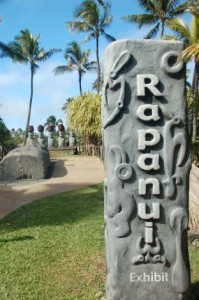
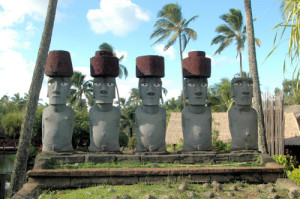
Rapa Nui is world famous for the several hundred mo’ai (monolithic human figures) which are scattered around the island, the god-like statues are ringa ora (living faces) of the Rapa Nui natives’ ancestors which are positioned on the island to look toward their original homeland. The mo’ai built at the Polynesian Cultural Center were made from specially formulated cement to closely duplicate the scoria (a type of volcanic rock) found on Rapa Nui, natives from the island were also brought to the Center to carve the cement statues of the exhibit.
Iosepa “Voyage of Discovery” Exhibit –
Tucked away among the villages of the Polynesian Cultural Center is a halau (a place of learning) which holds an almost 60 foot long double-hulled canoe made of Fijian dakua wood. Twice a day there is a presentation about how the Iosepa is used by BYU – Hawaii as a sailing classroom where students learn about now the ancient Polynesians navigated across the Pacific Ocean, when the Iosepa is not being used during the spring and summer months it is stored at the Center. Visitors to the exhibit will also learn about how a celestial navigation compass is used, how the canoe is prepared and the activities the “crew” will perform during an ocean voyage.
This concludes the Travel post on the Polynesian Cultural Center and for more specific visitor information, please check out their website- www.polynesia.com For more tourist information about planning a trip to Hawaii with suggestions on places to visit, please click on the Travel post link to Hawaii – the 50th State.

